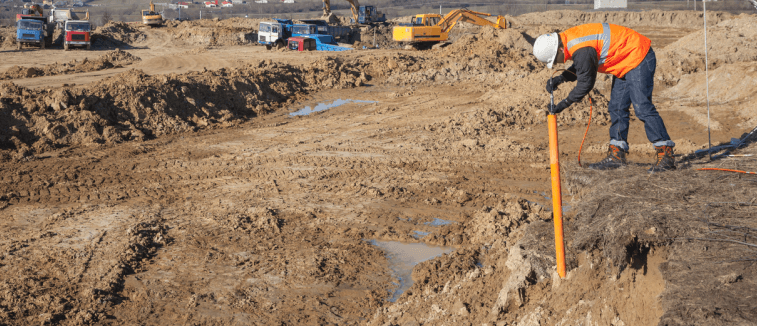Getting My Geotheta To Work
Getting My Geotheta To Work
Blog Article
7 Easy Facts About Geotheta Explained
Table of ContentsGeotheta Fundamentals ExplainedAn Unbiased View of GeothetaGeotheta Fundamentals ExplainedSee This Report about GeothetaThe 6-Minute Rule for Geotheta

They carry out website investigations, collect samples, carry out lab tests, and analyze data to examine the suitability of the ground for building and construction tasks - Geo Tech Engineer. Based upon their searchings for, geotechnical engineers offer recommendations for structure style, slope security, preserving frameworks, and mitigation of geotechnical dangers. They team up with various other experts, such as engineers, architectural engineers, and building and construction groups, to make certain that geotechnical considerations are incorporated into the general project design and application
By analyzing the habits and residential or commercial properties of soil and rock, they can identify possible geotechnical hazards such as landslides, dirt settlement, or incline instability. Their expertise aids stop failings or accidents that can endanger lives and building. Below are some comprehensive obligations and responsibilities of a geotechnical designer: Website Investigation: Geotechnical designers conduct site investigations to gather information on subsurface problems.
They translate the information to understand the properties and actions of the dirt and rock, including their strength, permeability, compaction attributes, and groundwater problems. Geotechnical Evaluation and Layout: Geotechnical designers examine the information accumulated throughout site examinations to examine the security and suitability of the site for construction jobs. They carry out geotechnical calculations and modeling to evaluate elements such as birthing capacity, settlement, slope stability, lateral earth stress, and groundwater circulation.
The 25-Second Trick For Geotheta
Foundation Style: Geotechnical engineers play a crucial duty in creating foundations that can securely support the desired framework. They examine the soil conditions and tons needs to determine the appropriate foundation kind, such as shallow structures (e.g., footings), deep foundations (e.g (https://geotheta-46958753.hubspotpagebuilder.com/blog/unlocking-the-future-with-top-notch-geotechnical-engineers-at-geotheta)., piles), or specialized strategies like dirt renovation. They take into consideration variables such as settlement restrictions, birthing ability, and soil-structure interaction to establish optimum structure designs
They evaluate building and construction strategies, screen website activities, and conduct area examinations to verify that the layout suggestions are complied with. If unforeseen geotechnical problems develop, they assess the circumstance and offer suggestions for remediation or modifications to the design. Danger Analysis and Reduction: Geotechnical designers examine geotechnical hazards and dangers connected with the task site, such as landslides, liquefaction, or dirt disintegration.

Partnership and Interaction: Geotechnical designers function closely with other experts involved in a task, such as designers, architectural designers, and building teams. Effective interaction and collaboration are necessary to integrate geotechnical considerations into the overall task layout and building procedure. Geotechnical designers provide technical proficiency, response queries, and make sure that geotechnical demands are satisfied.
Geotheta for Beginners
Here are some sorts of geotechnical engineers: Structure Designer: Structure designers specialize in creating and assessing foundations for structures. They evaluate the soil problems, tons needs, and site qualities to determine one of the most proper foundation kind and design, such as shallow structures, deep structures, or specialized methods like stack structures.
They review the factors influencing slope security, such as soil residential properties, groundwater conditions, and slope geometry, and establish strategies to avoid slope failures and minimize dangers. Earthquake Engineer: Quake engineers concentrate on evaluating and designing frameworks to stand up to seismic pressures. They evaluate the seismic threat of a site, examine soil liquefaction potential, and create seismic design criteria to make sure the security and resilience of structures throughout quakes.
They perform field testing, collect examples, and evaluate the accumulated information to define the soil residential properties, geologic formations, and groundwater problems at a site. Geotechnical Instrumentation Engineer: Geotechnical instrumentation designers concentrate on monitoring and gauging the behavior of dirt, rock, and frameworks. They mount and keep instrumentation systems that check elements such as soil negotiation, groundwater levels, incline activities, and structural variations to evaluate efficiency and offer very early cautions of potential issues.
Some Known Details About Geotheta
They carry out examinations such as triaxial tests, consolidation examinations, direct shear examinations, and permeability examinations to gather information for geotechnical analysis and style. Geosynthetics Designer: Geosynthetics engineers specialize in the layout and application of geosynthetic materials, such as geotextiles, geogrids, and geomembranes. They utilize these materials to improve soil security, enhance slopes, supply drainage remedies, and control disintegration.
They have a tendency to be investigatory individuals, which indicates they're intellectual, reflective, and curious. They are curious, methodical, logical, logical, and rational. Some of them are additionally social, implying they're kind, generous, participating, client, caring, useful, compassionate, tactful, and friendly - Geotechnical Engineers.
In the workplace setting, geotechnical designers utilize specialized software devices to carry out computations, develop layouts, and examine data. They prepare records, testimonial task specifications, communicate with clients and team participants, and coordinate project activities. The workplace setup offers a conducive environment for research study, analysis, and partnership with other specialists involved in the task.
An Unbiased View of Geotheta
They regularly visit task sites to perform website examinations, evaluate geotechnical conditions, and collect information for evaluation. These visits involve taking a trip to different areas, often in remote or tough surfaces. Geotechnical designers may carry out soil tasting, conduct examinations, and display building and construction activities to make sure that the geotechnical facets of the project are being implemented correctly.
Geotechnical engineers also work in specialized geotechnical laboratories. Geotechnical research laboratory engineers function thoroughly in these environments, dealing with screening tools, operating instruments, and tape-recording data.
Report this page